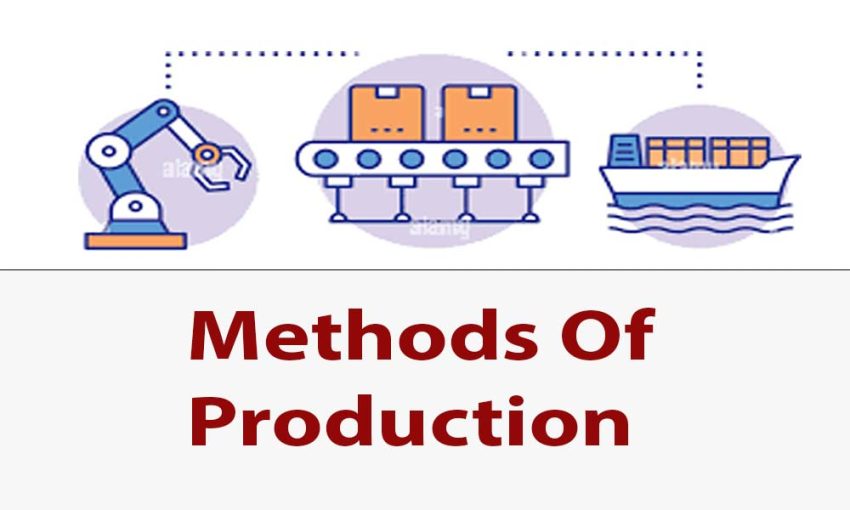Methods of production are critical for any business aiming to manufacture goods and produce services. These methods dictate product creation, impacting production efficiency, quality, and cost.
There are various production methods, including job, batch, mass, and continuous production. Each method has unique characteristics, advantages, and disadvantages, making it more suitable for different businesses and products.
By understanding the different types of production methods, businesses can choose the most appropriate method for their needs, maximizing production efficiency and profitability.
I will describe details about these methods in this blog post to better understand them. Scroll down to read and continue.
What Are The Different Methods of Production?

Methods of Production refer to the different techniques and approaches used to manufacture goods and provide services. These methods vary depending on the type of industry, the resources available, and the level of technology used.
Now, I will describe some best methods of production along with their characteristics, advantages, disadvantages, and examples.
Job Production
Job production is a production method in which a product is manufactured to meet a customer’s needs. It involves the production of one product at a time.
Characteristics:
This method is suitable for customized or unique products. It requires a high level of skill and expertise in the production process. It involves a high level of interaction between the producer and the customer.
Advantages:
- High-quality products
- Better customer satisfaction
- The flexibility to modify the product during production
- The ability to charge premium prices
Disadvantages:
- High production cost
- Low production volume
- Inefficient use of resources
- Longer lead times
Examples:
Custom-made furniture, tailor-made clothing, and one-of-a-kind art pieces are products made using job production.
Batch Production
Batch production is a method of production where a group of similar products is produced simultaneously.
Characteristics:
Batch production is suitable for products that have similar characteristics. It involves the use of standardized processes and equipment. It allows for economies of scale.
Advantages:
- Reduced production time
- Lower production cost per unit
- Higher efficiency
- Economies of scale
Disadvantages:
- Inflexibility in making changes during production
- Higher setup cost
- The possibility of producing defective products.
Examples:
Baked goods, pharmaceuticals, and electronics are methods of product examples often produced using batch production.
Continuous Production
Continuous production is a method of production where the production process is continuous, and the products are produced in large quantities.
Characteristics:
Continuous production is suitable for products that have a high demand. It involves the use of automated processes and equipment. It allows for the production of a large quantity of products in a short amount of time.
Advantages:
- High productivity
- Reduced labor cost
- High efficiency
- Short lead times
Disadvantages:
- High setup cost
- Limited flexibility
- High risk of breakdowns
- Limited ability to produce multiple products
Examples:
Chemicals, petroleum, and electricity are products often produced using continuous production.
Mass production
Mass production involves manufacturing large quantities of identical products using automated processes and specialized equipment.
Characteristics:
Mass production is often used for high-volume products. The production process is highly automated and standardized. The workforce is mainly unskilled and performs repetitive tasks.
Advantages:
- Low production cost per unit
- High efficiency
- High productivity
- Short lead times
Disadvantages:
- Limited flexibility
- High setup cost
- Poor product quality
- The need for high investment in equipment and infrastructure
Example:
Automobiles, consumer electronics, and packaged foods are examples of products that are often produced using mass production..
In conclusion, the method of production used depends on the product’s nature and the demand level. Each way of making something has its own pros and cons, which are essential to think about when choosing a way to make something.
Methods of Production: Must Watch For Better Understand
Comparison of the different methods of production
Here is a comparison of the different types of production methods:
| Points | Job Production | Batch Production | Mass Production | Continuous Production |
| Customization | High degree | Moderate degree | No customization | No customization |
| Production volume | Low | Modium | high | high |
| Skill labor | Required | Requires a mix of skilled and unskilled labor | Use of unskilled labor | Fully automatic process |
| Product cost | High | Moderate | low | low |
As you can see, each production method has its unique characteristics, advantages, and disadvantages. Job and batch production is ideal for customized products, while mass and continuous production are more suitable for standardized products.
Each method has different labor, production volume, and cost requirements, and businesses must evaluate these factors to choose the most appropriate method for their needs. Ultimately, the goal of any production method is to maximize efficiency, quality, and profitability while meeting customer needs and expectations.
Factors To Consider When Choosing A Production Method

When choosing a production method, businesses must consider several factors to ensure they choose the most appropriate method for their needs. Some of the key factors to consider include:
Product Characteristics:
The product’s characteristics, such as size, complexity, and customization, will influence the choice of production method. For instance, job production is ideal for customized products, while mass production is more suitable for standardized products.
Production Volume:
The expected production volume will influence the choice of production method. Batch production is ideal for moderate production volumes, while mass and continuous production are more suitable for high production volumes.
Cost:
The production cost of each method should be evaluated to determine which method is the most cost-effective. For instance, job production may be more expensive due to the high level of customization, while mass production may have a lower cost per unit due to economies of scale.
Production Efficiency:
The efficiency of each production method should be evaluated to ensure that the method can meet the desired production targets. Factors such as production time, lead times, and productivity should be considered.
Flexibility:
The flexibility of the production method to adapt to changes in demand or product specifications should also be considered. For instance, job production may be more flexible than mass production as it allows for modifications during production.
Equipment and Infrastructure:
The required equipment and infrastructure for each production method should also be evaluated to determine if it is feasible for the business. For example, investing a lot in specialized equipment and infrastructure may be needed for continuous manufacturing.
By considering these things, firms may choose the most efficient, high-quality, and profitable way to make their products while still meeting client wants and expectations.
Wrap Up
In conclusion, the method of production a business chooses plays a critical role in its success. It impacts production efficiency, quality, and cost, which in turn, affect profitability. By understanding the different types of production methods, businesses can make informed decisions and choose the most appropriate method for their needs.
It’s essential to continuously evaluate and improve production methods to remain competitive and meet changing market demands. Ultimately, the goal of any production method is to maximize efficiency, quality, and profitability while meeting customer needs and expectations.
With a suitable production method in place, businesses can achieve these goals and thrive in their respective markets.
Must View More Articles:

